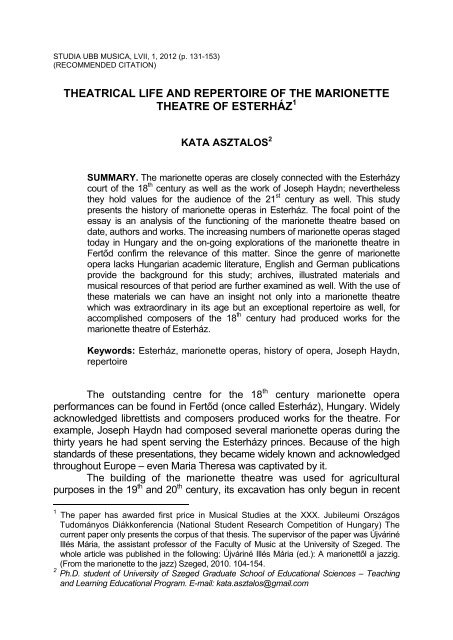musica - Studia
musica - Studia
musica - Studia
Create successful ePaper yourself
Turn your PDF publications into a flip-book with our unique Google optimized e-Paper software.
STUDIA UBB MUSICA, LVII, 1, 2012 (p. 131-153)<br />
(RECOMMENDED CITATION)<br />
THEATRICAL LIFE AND REPERTOIRE OF THE MARIONETTE<br />
THEATRE OF ESTERHÁZ 1<br />
KATA ASZTALOS 2<br />
SUMMARY. The marionette operas are closely connected with the Esterházy<br />
court of the 18 th century as well as the work of Joseph Haydn; nevertheless<br />
they hold values for the audience of the 21 st century as well. This study<br />
presents the history of marionette operas in Esterház. The focal point of the<br />
essay is an analysis of the functioning of the marionette theatre based on<br />
date, authors and works. The increasing numbers of marionette operas staged<br />
today in Hungary and the on-going explorations of the marionette theatre in<br />
Fertőd confirm the relevance of this matter. Since the genre of marionette<br />
opera lacks Hungarian academic literature, English and German publications<br />
provide the background for this study; archives, illustrated materials and<br />
<strong>musica</strong>l resources of that period are further examined as well. With the use of<br />
these materials we can have an insight not only into a marionette theatre<br />
which was extraordinary in its age but an exceptional repertoire as well, for<br />
accomplished composers of the 18 th century had produced works for the<br />
marionette theatre of Esterház.<br />
Keywords: Esterház, marionette operas, history of opera, Joseph Haydn,<br />
repertoire<br />
The outstanding centre for the 18 th century marionette opera<br />
performances can be found in Fertőd (once called Esterház), Hungary. Widely<br />
acknowledged librettists and composers produced works for the theatre. For<br />
example, Joseph Haydn had composed several marionette operas during the<br />
thirty years he had spent serving the Esterházy princes. Because of the high<br />
standards of these presentations, they became widely known and acknowledged<br />
throughout Europe – even Maria Theresa was captivated by it.<br />
The building of the marionette theatre was used for agricultural<br />
purposes in the 19 th and 20 th century, its excavation has only begun in recent<br />
1 The paper has awarded first price in Musical Studies at the XXX. Jubileumi Országos<br />
Tudományos Diákkonferencia (National Student Research Competition of Hungary) The<br />
current paper only presents the corpus of that thesis. The supervisor of the paper was Újváriné<br />
Illés Mária, the assistant professor of the Faculty of Music at the University of Szeged. The<br />
whole article was published in the following: Újváriné Illés Mária (ed.): A marionettől a jazzig.<br />
(From the marionette to the jazz) Szeged, 2010. 104-154.<br />
2 Ph.D. student of University of Szeged Graduate School of Educational Sciences – Teaching<br />
and Learning Educational Program. E-mail: kata.asztalos@gmail.com

















